| Listing 1 - 9 of 9 |
Sort by
|
Book
ISBN: 1281934038 9786611934033 9812791949 9789812791948 9781281934031 Year: 2001 Publisher: Singapore New Jersey World Scientific
Abstract | Keywords | Export | Availability | Bookmark
 Loading...
Loading...Choose an application
- Reference Manager
- EndNote
- RefWorks (Direct export to RefWorks)
In view of the rapid growth in both experimental and theoretical studies of multi-photon processes and multi-photon spectroscopy of atoms, ions and molecules in chemistry, physics, biology, materials science, etc., it is desirable to publish an advanced series of volumes containing review papers that can be read not only by active researchers in these areas, but also by those who are not experts but who intend to enter the field. The present series aims to serve this purpose. Each review article is written in a self-contained manner by the expert(s) in the area, so that the reader can grasp the knowledge without too much preparation.
Spectrum analysis. --- Spectroscope. --- Astronomical instruments --- Spectrum analysis --- Analysis, Spectrum --- Spectra --- Spectrochemical analysis --- Spectrochemistry --- Spectrometry --- Spectroscopy --- Chemistry, Analytic --- Interferometry --- Optics --- Radiation --- Wave-motion, Theory of --- Absorption spectra --- Light --- Spectroscope --- Instruments --- Qualitative --- Analytical chemistry
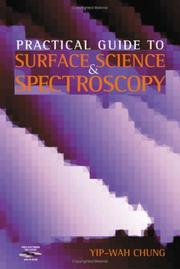
ISBN: 1281010928 9786611010928 0080497780 0121746100 9781429482837 1429482834 9780121746100 9780080497785 0121746119 Year: 2001 Publisher: San Diego Academic Press
Abstract | Keywords | Export | Availability | Bookmark
 Loading...
Loading...Choose an application
- Reference Manager
- EndNote
- RefWorks (Direct export to RefWorks)
Practical Guide to Surface Science and Spectroscopy provides a practical introduction to surface science as well as describes the basic analytical techniques that researchers use to understand what occurs at the surfaces of materials and at their interfaces. These techniques include auger electron spectroscopy, photoelectron spectroscopy, inelastic scattering of electrons and ions, low energy electron diffraction, scanning probe microscopy, and interfacial segregation. Understanding the behavior of materials at their surfaces is essential for materials scientists and engineers as they
Surfaces (Physics) --- Spectrum analysis. --- Analysis, Spectrum --- Spectra --- Spectrochemical analysis --- Spectrochemistry --- Spectroscopy --- Chemistry, Analytic --- Interferometry --- Optics --- Radiation --- Wave-motion, Theory of --- Absorption spectra --- Light --- Spectroscope --- Physics --- Surface chemistry --- Surfaces (Technology) --- Qualitative --- Spectrometry --- Analytical chemistry
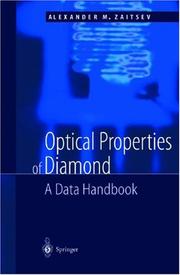
ISBN: 354066582X 3642085857 3662045486 Year: 2001 Publisher: Berlin Springer
Abstract | Keywords | Export | Availability | Bookmark
 Loading...
Loading...Choose an application
- Reference Manager
- EndNote
- RefWorks (Direct export to RefWorks)
This is the most comprehensive handbook on optical properties of diamond ever written. The book does not contain lengthy discussions, instead, it is an accessible collection of data accompanied by short explanations. Much of the data presented in this book is available here for the first time in English. The text contains, in addition to the authors own views, those of other researchers - even where the two interpetations are at odds. Thus all interested students and researchers will benefit from the complete picture offered by this compilation.
Electronics and optics of solids --- Diamonds --- Diamonds, Artificial --- Optical properties --- Solid state physics. --- Materials science. --- Physical chemistry. --- Spectroscopy. --- Microscopy. --- Crystallography. --- Solid State Physics. --- Materials Science, general. --- Physical Chemistry. --- Spectroscopy and Microscopy. --- Characterization and Evaluation of Materials. --- Crystallography and Scattering Methods. --- Leptology --- Physical sciences --- Mineralogy --- Analysis, Microscopic --- Light microscopy --- Micrographic analysis --- Microscope and microscopy --- Microscopic analysis --- Optical microscopy --- Optics --- Analysis, Spectrum --- Spectra --- Spectrochemical analysis --- Spectrochemistry --- Spectrometry --- Spectroscopy --- Chemistry, Analytic --- Interferometry --- Radiation --- Wave-motion, Theory of --- Absorption spectra --- Light --- Spectroscope --- Chemistry, Theoretical --- Physical chemistry --- Theoretical chemistry --- Chemistry --- Material science --- Physics --- Solids --- Qualitative --- Analytical chemistry
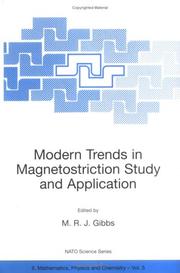
ISBN: 0792367170 0792367162 9401009597 Year: 2001 Volume: v. 5 Publisher: Dordrecht ; Boston ; London Brussels Kluwer Academic Publishers NATO Scientific Affairs Division
Abstract | Keywords | Export | Availability | Bookmark
 Loading...
Loading...Choose an application
- Reference Manager
- EndNote
- RefWorks (Direct export to RefWorks)
An understanding of magnetostriction is important for a range of technologically and scientifically important materials. The book covers bulk and thin film magnetostrictive materials, superconductors and oxides. The role of magnetostriction in determining or influencing the physical properties is discussed in depth and wide-ranging reference lists are provided for further study. Contributors have provided both tutorial material and discussions of leading-edge science. Readership: An invaluable reference for all condensed matter physicists, material scientists and technologists for whom bulk or thin film magnetic materials or superconductors are central to their interests.
Magnetostriction --- Magnétisme --- Congresses. --- Congrès --- Magnetism. --- Magnetic materials. --- Solid state physics. --- Spectroscopy. --- Microscopy. --- Condensed matter. --- Materials—Surfaces. --- Thin films. --- Magnetism, Magnetic Materials. --- Solid State Physics. --- Spectroscopy and Microscopy. --- Condensed Matter Physics. --- Surfaces and Interfaces, Thin Films. --- Films, Thin --- Solid film --- Solid state electronics --- Solids --- Surfaces (Technology) --- Coatings --- Thick films --- Condensed materials --- Condensed media --- Condensed phase --- Materials, Condensed --- Media, Condensed --- Phase, Condensed --- Liquids --- Matter --- Analysis, Microscopic --- Light microscopy --- Micrographic analysis --- Microscope and microscopy --- Microscopic analysis --- Optical microscopy --- Optics --- Analysis, Spectrum --- Spectra --- Spectrochemical analysis --- Spectrochemistry --- Spectrometry --- Spectroscopy --- Chemistry, Analytic --- Interferometry --- Radiation --- Wave-motion, Theory of --- Absorption spectra --- Light --- Spectroscope --- Physics --- Materials --- Mathematical physics --- Electricity --- Magnetics --- Qualitative --- Analytical chemistry
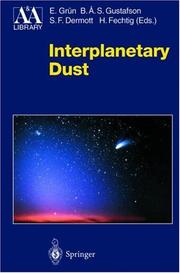
ISBN: 3540420673 3642626475 3642564283 Year: 2001 Publisher: Berlin : Springer,
Abstract | Keywords | Export | Availability | Bookmark
 Loading...
Loading...Choose an application
- Reference Manager
- EndNote
- RefWorks (Direct export to RefWorks)
This is a handbook on the physics of interplanetary dust, a topic of interest not only to astronomers and space scientists but also to engineers. The following topics are covered in the book: historical perspectives; cometary dust; near-Earth environment; meteoroids and meteors; properties of interplanetary dust, information from collected samples; in situ measurements of cosmic dust; numerical modeling of the Zodiacal Cloud structure; synthesis of observations; instrumentation; physical processes; optical properties of interplanetary dust; orbital evolution of interplanetary dust; circumplanetary dust, observations and simple physics; interstellar dust and circumstellar dust disks.
Interplanetary dust. --- Interplanetary dust --- Astrophysics. --- Physical geography. --- Space Sciences (including Extraterrestrial Physics, Space Exploration and Astronautics). --- Geophysics/Geodesy. --- Astronomy, Observations and Techniques. --- Solid State Physics. --- Spectroscopy and Microscopy. --- Geography --- Astronomical physics --- Astronomy --- Cosmic physics --- Physics --- Space sciences. --- Geophysics. --- Observations, Astronomical. --- Astronomy—Observations. --- Solid state physics. --- Spectroscopy. --- Microscopy. --- Analysis, Microscopic --- Light microscopy --- Micrographic analysis --- Microscope and microscopy --- Microscopic analysis --- Optical microscopy --- Optics --- Analysis, Spectrum --- Spectra --- Spectrochemical analysis --- Spectrochemistry --- Spectrometry --- Spectroscopy --- Chemistry, Analytic --- Interferometry --- Radiation --- Wave-motion, Theory of --- Absorption spectra --- Light --- Spectroscope --- Solids --- Astronomical observations --- Observations, Astronomical --- Geological physics --- Terrestrial physics --- Earth sciences --- Science and space --- Space research --- Cosmology --- Science --- Qualitative --- Analytical chemistry

ISBN: 0792369483 0792369475 9401007381 Year: 2001 Publisher: Dordrecht ; Boston ; London Brussels Kluwer Academic Publishers NATO Scientific Affairs Division
Abstract | Keywords | Export | Availability | Bookmark
 Loading...
Loading...Choose an application
- Reference Manager
- EndNote
- RefWorks (Direct export to RefWorks)
This volume contains papers presented at the NATO Advanced Study Institute (ASI) Photonic Crystals and Light Localization held at the Creta Maris Hotel in Limin Hersonissou, Crete, June 18-30, 2000. Photonic crystals offer unique ways to tailor light and the propagation of electromagnetic waves (EM). In analogy to electrons in a crystal, EM waves propagating in a structure with a periodically modulated dielectric constant are organized into photonic bands, separated by gaps where propagating states are forbidden. There have been proposals for novel applications ofthese photonic band gap (PBG) crystals, with operating frequencies ranging from microwave to the optical regime, that include zero threshold lasers, low-loss resonators and cavities, and efficient microwave antennas. Spontaneous emission, suppressed for photons in the photonic band gap, offers novel approaches to manipulate the EM field and create high-efficiency light-emitting structures. Innovative ways to manipulate light can have a profound iofluence on science and technology.
Photons --- Congresses --- Crystal optics --- Optics. --- Electrodynamics. --- Physical chemistry. --- Mathematical physics. --- Solid state physics. --- Spectroscopy. --- Microscopy. --- Electrical engineering. --- Classical Electrodynamics. --- Physical Chemistry. --- Theoretical, Mathematical and Computational Physics. --- Solid State Physics. --- Spectroscopy and Microscopy. --- Electrical Engineering. --- Analysis, Microscopic --- Light microscopy --- Micrographic analysis --- Microscope and microscopy --- Microscopic analysis --- Optical microscopy --- Optics --- Analysis, Spectrum --- Spectra --- Spectrochemical analysis --- Spectrochemistry --- Spectrometry --- Spectroscopy --- Chemistry, Analytic --- Interferometry --- Radiation --- Wave-motion, Theory of --- Absorption spectra --- Light --- Spectroscope --- Physics --- Solids --- Electric engineering --- Engineering --- Physical mathematics --- Chemistry, Theoretical --- Physical chemistry --- Theoretical chemistry --- Chemistry --- Dynamics --- Qualitative --- Mathematics --- Analytical chemistry --- Optique cristalline
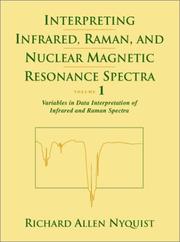
ISBN: 9780125234757 0125234759 9780080535135 0080535135 0125234708 9786611118617 1281118613 Year: 2001 Publisher: San Diego : Academic Press,
Abstract | Keywords | Export | Availability | Bookmark
 Loading...
Loading...Choose an application
- Reference Manager
- EndNote
- RefWorks (Direct export to RefWorks)
This book teaches the analyst why it is advantageous to obtain vibrational data under different physical phases. Molecular vibrations are affected by change in physical phase, and knowledge of how certain molecular vibrations are affected by change in the chemical environment improves the analyst's ability to solve complex chemical problems.This book is invaluable for students and scientists engaged in analytical and organic chemistry, since application of IR and Raman spectroscopy is essential in identifying and verifying molecular structure.This reference provides analysts w
Theoretical spectroscopy. Spectroscopic techniques --- Spectrometric and optical chemical analysis --- Organic spectroscopy --- Spectrum analysis. --- Infrared spectroscopy. --- Raman spectroscopy. --- Nuclear magnetic resonance spectroscopy. --- Chemistry, Analytic. --- Analysis, Chemical --- Analytic chemistry --- Chemical analysis --- Chemistry, Analytic --- Chemistry --- NMR spectroscopy --- Spectroscopy, NMR --- Spectroscopy, Nuclear magnetic resonance --- Nuclear spectroscopy --- Knight shift --- CARS spectroscopy --- Coherent anti-Stokes Raman spectroscopy --- Spectroscopy, Raman --- Spectrum analysis --- Infra-red spectrometry --- Infrared spectrometry --- Spectrometry, Infrared --- Spectroscopy, Infrared --- Optical spectroscopy --- Analysis, Spectrum --- Spectra --- Spectrochemical analysis --- Spectrochemistry --- Spectrometry --- Spectroscopy --- Analytical chemistry --- Interferometry --- Optics --- Radiation --- Wave-motion, Theory of --- Absorption spectra --- Light --- Spectroscope --- Qualitative
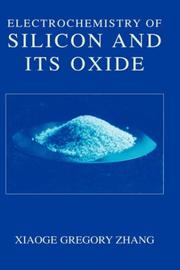
ISBN: 9780306465413 0306465418 9780306479212 0306479214 Year: 2001 Publisher: New York (N.Y.) : Kluwer academic/Plenum,
Abstract | Keywords | Export | Availability | Bookmark
 Loading...
Loading...Choose an application
- Reference Manager
- EndNote
- RefWorks (Direct export to RefWorks)
It may be argued that silicon, carbon, hydrogen, oxygen, and iron are among the most important elements on our planet, because of their involvement in geological, biol- ical, and technological processes and phenomena. All of these elements have been studied exhaustively, and voluminous material is available on their properties. Included in this material are numerous accounts of their electrochemical properties, ranging from reviews to extensive monographs to encyclopedic discourses. This is certainly true for C, H, O, and Fe, but it is true to a much lesser extent for Si, except for the specific topic of semiconductor electrochemistry. Indeed, given the importance of the elect- chemical processing of silicon and the use of silicon in electrochemical devices (e. g. , sensors and photoelectrochemical cells), the lack of a comprehensive account of the electrochemistry of silicon in aqueous solution at the fundamental level is surprising and somewhat troubling. It is troubling in the sense that the non-photoelectrochemistry of silicon seems “to have fallen through the cracks,” with the result that some of the electrochemical properties of this element are not as well known as might be warranted by its importance in a modern technological society. Dr. Zhang’s book, Electrochemical Properties of Silicon and Its Oxide, will go a long way toward addressing this shortcoming. As with his earlier book on the elect- chemistry of zinc, the present book provides a comprehensive account of the elect- chemistry of silicon in aqueous solution.
Electrochemistry. --- Silicon compounds --- Semiconductors --- Electrochimie --- Electric properties. --- 546.28 --- 541.13 --- Silicon Si --- Electrochemistry --- Analytical biochemistry. --- Chemical engineering. --- Chemistry. --- Computer engineering. --- Semiconductors - Electric properties. --- Chemistry --- Physical Sciences & Mathematics --- Physical & Theoretical Chemistry --- Electric properties --- 541.13 Electrochemistry --- 546.28 Silicon Si --- Analytical chemistry. --- Solid state physics. --- Spectroscopy. --- Microscopy. --- Electrical engineering. --- Analytical Chemistry. --- Electrical Engineering. --- Industrial Chemistry/Chemical Engineering. --- Solid State Physics. --- Spectroscopy and Microscopy. --- Chemicals --- Crystalline semiconductors --- Semi-conductors --- Semiconducting materials --- Semiconductor devices --- Crystals --- Electrical engineering --- Electronics --- Solid state electronics --- Chemistry, Physical and theoretical --- Materials --- Analysis, Microscopic --- Light microscopy --- Micrographic analysis --- Microscope and microscopy --- Microscopic analysis --- Optical microscopy --- Optics --- Analysis, Spectrum --- Spectra --- Spectrochemical analysis --- Spectrochemistry --- Spectrometry --- Spectroscopy --- Chemistry, Analytic --- Interferometry --- Radiation --- Wave-motion, Theory of --- Absorption spectra --- Light --- Spectroscope --- Physics --- Solids --- Chemistry, Industrial --- Engineering, Chemical --- Industrial chemistry --- Engineering --- Chemistry, Technical --- Metallurgy --- Electric engineering --- Analysis, Chemical --- Analytic chemistry --- Chemical analysis --- Qualitative --- Analytical chemistry
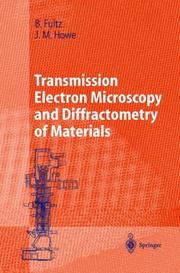
ISSN: 14392674 ISBN: 3540678417 3662045184 3662045168 9783540678410 Year: 2001 Publisher: Berlin : Springer,
Abstract | Keywords | Export | Availability | Bookmark
 Loading...
Loading...Choose an application
- Reference Manager
- EndNote
- RefWorks (Direct export to RefWorks)
This book teaches graduate students the concepts of trans- mission electron microscopy (TEM) and x-ray diffractometry (XRD) that are important for the characterization of materi- als. It emphasizes themes common to both techniques, such as scattering from atoms and the formation and analysis of dif- fraction patterns. It also describes unique aspects of each technique, especially imaging and spectroscopy in the TEM. The textbook thoroughly develops both introductory and ad- vanced-level material, using over 400 accompanying illustra- tions. Problems are provided at the end of each chapter to reinforce key concepts. Simple citatioins of rules are avoi- ded as much as possible, and both practical and theoretical issues are explained in detail. The book can be used as both an introductory and advanced-level graduate text since sec- tions/chapters are sorted according to difficulty and grou- ped for use in quarter and semester courses on TEM and XRD.
Materials --- Transmission electron microscopy. --- X-ray diffractometer. --- Microscopy. --- 620.18 --- Investigation of structure of materials. Metallography. Analogous study of non-metals --- 620.18 Investigation of structure of materials. Metallography. Analogous study of non-metals --- Transmission electron microscopy --- X-ray diffractometer --- Diffractometer, X-ray --- X-rays --- Electron microscopy --- Microscopy --- Equipment and supplies --- Monograph --- Spectroscopy. --- Surfaces (Physics). --- Interfaces (Physical sciences). --- Thin films. --- Solid state physics. --- Materials—Surfaces. --- Spectroscopy and Microscopy. --- Surface and Interface Science, Thin Films. --- Solid State Physics. --- Surfaces and Interfaces, Thin Films. --- Physics --- Solids --- Films, Thin --- Solid film --- Solid state electronics --- Surfaces (Technology) --- Coatings --- Thick films --- Surface chemistry --- Surfaces (Physics) --- Analysis, Microscopic --- Light microscopy --- Micrographic analysis --- Microscope and microscopy --- Microscopic analysis --- Optical microscopy --- Optics --- Analysis, Spectrum --- Spectra --- Spectrochemical analysis --- Spectrochemistry --- Spectrometry --- Spectroscopy --- Chemistry, Analytic --- Interferometry --- Radiation --- Wave-motion, Theory of --- Absorption spectra --- Light --- Spectroscope --- Qualitative --- Analytical chemistry --- Materials - Microscopy.
| Listing 1 - 9 of 9 |
Sort by
|

 Search
Search Feedback
Feedback About UniCat
About UniCat  Help
Help News
News